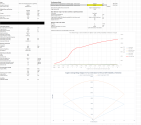After tinkering a bit more on AN/SPY-7 including digging its factsheet. Turn out that i am mistaken in my frequency estimates.
Tracing back to original LRDR in US. The antenna was 60 x 60 Feet (18.24 x 18.24) and consist of 10 large panels arranged in "5x2". Thus one panel has about 18.24/5 = 3.65 m and height of 18.24/2 = 9.12 m. Thus one panel of LRDR have area of 33.3 sqm. so 10 Panels makes it 333 sqm.
Each panel have about 288 "slots" for SAS (Subarray Antenna Suite), 10 panels thus making total of 2880. each SAS have 37 TRM Channels. Therefore total TRM counts for LRDR is about 2880 x 37 = 106560 TRM. Frequency estimates can thus be made from there. First is to divide the area with the TRM counts to get the element area, so :
333/106560 = 0.00312 sqm.
Then One needs to know the spacing arrangement for the radar's element, typically it's triangular which provides cost saving (compared to say "box" arrangement as it's will need about 14% more TRM, good for power aperture maybe but bad for your wallet and cooling) Thus the frequency can be estimated with this :
Ae = k * wavelength^2. Where Ae is element area which is known, k is "scanning constant" the deriviation of which one can read in "Radar handbook 3rd Edition". For Full FOV Array for which the array is scanning a full 120 degrees of arc the k equals to 0.332. Thus we have :
0.0312 = 0.332* wavelength^2
Wavelength = (0.00312/0.332)^(1/2)
Wavelength = 0.097 m or frequency of 3093 MHz (3 GHz) Same ballpark as SPY-6 (3.7 GHz) and Type 346 (3.3 GHz)
Now that we know the frequency and Element area, we can then estimate the "TRM Equivalent count" for the ASEV's AN/SPY-7 V1.
based on Japanese Senator Sato Masahisa's tweet the antenna is about 4.2 x 5 meter.
Not that much different than in the previously provided Yahoo articles. Anyway since the aperture is a box or near it, the area can be estimated as 21 sqm. Since we now know the element area we can divide that 21 sqm with the known LRDR elements.
21/0.00312 = 6730 TRM.
-----------
For detection range. I would assume LRDR to be designed with ABM Treaty limit of average power of 3 MW/sqm. This average power limit can be used to find the required TRM rating. Since the antenna area and TRM count is known which is 333 and 106560 respectively. First thing to do is to find how much/sqm average power required to be emitted by the array :
Pav/sqm = 3000000/333
Pav/sqm = 9009 Watt/sqm to meet the ABM treaty limit.
and then we need to find how many TRM available/ sqm of the area for which we can divide the TRM numbers with area
N/sqm= 106560/333
N/sqm= 320
Thus the average power needed for each TRM would be :
Pav/TRM = 9009/320
Pav = 28.15 Watt
Assuming long pulse of 10 us and say medium PRF of 20 KHz making it about 20% duty cycle, we can find the Peak power required by the TRM which is :
PPeak = 28.15/0.2
PPeak = 140.8 Watt.
Then i guess enough data is available for range estimates. others like capacity (track vs search resource allocation) could be assumed from literature. Which yield following for the LRDR.

Which shows for the provided power aperture and some assumption on search area (120 x 2 degrees, barrier scan) The ABM treaty limit LRDR is capable of detecting a 10 sqm target like ascending ICBM from 14000 km with PD of 50% or 8800 km with PD of 90%.
Now that we established the value for US LRDR.. how would Japanese ASEV fare ? It's simpler to calculate as TRM counts are known.
AESA radar power aperture and range are related to cube of its TRM or "N^3" factor. We could use that relationship in following :
R=Rlrdr*(((Nasev/Nlrdr)^3)^(1/4))
Thus let's say we want 90% PD then we use the value for PD 90% range of 8800 km.
R=8800*(((6730/106560)^3)^(1/4))
R=1108.65 km
With value of 1835 km for PD 50%.
Thus we can see the ASEV would have range about 1108 to 1835 km against a 10 sqm ballistic target. If ASEV is also designed with ABM treaty limit in mind, the smaller aperture area of it will demand considerable 2.1 KW peak power and over 400 KW of average power/ element.
More complex calculation tho.. indicates much better range. As it's now taking account of beam broadening coming from smaller aperture. One typically want a narrow beam. Calculated beamwidth of the LRDR was 0.4 degrees, this might not be realistic as it's gonna take ages to scan the sector of interest, as a result typically large phased array's beamwidth are tapered with some algorithm to defocus the beam.
While ASEV's calculated beamwidth is more in line with SPY-1 which about 1.4 degrees. Lesser beam sectors needs to be scanned and thus more pulses are available for integration.

The more complex calculation for the ASEV indicates a much better range figure of 2048 to 3147 km for 10 sqm target.


